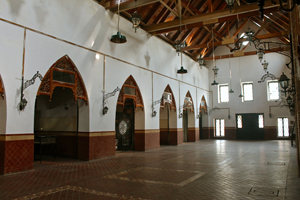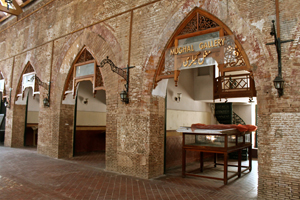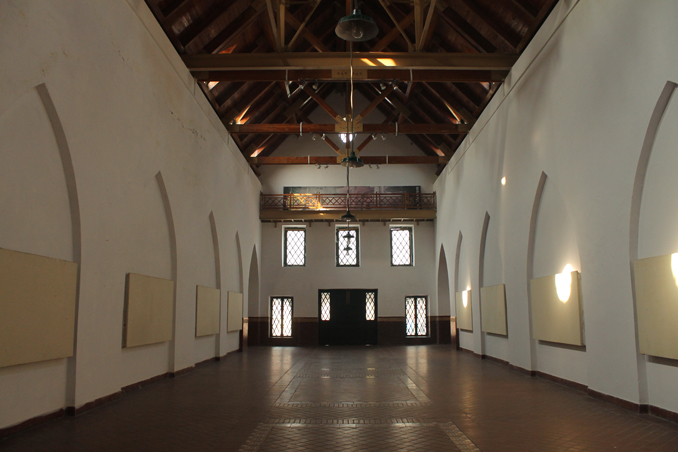Written by: Aleeza Rasool |  Comments | 中国 (Chinese)
Comments | 中国 (Chinese)
Google Translation: اُردو | 中文
As one crosses the old Anarkali Bazaar to one’s right, out emerges the Lahore City Heritage Museum - a single storied structure, reminiscent of Anglo-Indian architecture, which vividly breaks the monotony of the large, red brick buildings located adjacent and opposite to it on Mall Road. This building, now an annex of the Lahore Museum, was previously Lahore’s old Tollinton Market.
 |
I entered the building feeling quite skeptical about the state that it might be in, considering what I know of the lack of preservation of historical monuments in Pakistan. But on stepping inside, all preconceived notions were brushed aside. A silver shield mounted on the wall outside the main door stated that the building had undergone reconstruction and maintenance between the years 2004 and 2006. The Officer In-Charge explained that within the process of reconstruction, the building’s original design and features had been preserved and no changes had been made to it. It undoubtedly looked flawless.
The façade of the building boosts an elaborate veranda on all sides supported on wooden posts. The pitched roof has been finished in terracotta and is supported with two black towers made from wrought iron and glass. The purpose of these towers is to provide the main halls of the building with natural light. Inside, the wooden ceilings, a key feature of the place captures one’s attention, an intricate web of wooden beams and shafts that runs along the ceiling in all the halls. The main, square shaped hall, leads to two larger rectangular halls on either side, which are lit by numerous small windows near the ceiling. The blend of colours, owing to the red sandstone floor, the brown and mahogany ceilings and the white and red brick walls, has a soothing effect on one’s senses.
 |
Built in the year 1864 under the patronage of Queen Victoria, the old Tollinton Market was originally constructed for the purpose of holding the internationally acclaimed Punjab Industrial Exhibition. The success of the exhibition encouraged the British government towards making the market a permanent site for exhibitions. However in the year 1894, the collections displayed were shifted elsewhere and the market was commercialized. Eventually over the years it transformed into one of the busiest commercial centres located in old Lahore where everything from food items to pets was sold. According to Dr Rafiq Ahmed, owner of the Punjab Store which was once located within the old Tollinton market, this market was considered the most central and ideal place to shop until the mid 1940s (Malik). Douglass within her memoirs of Lahore refers to the variety of items available for sale within the market, “The main gallery held a kiosk that displayed a variety of merchandise… Jim led me out a side door to a yard where crates of live chicken were for sale… American brand merchandise was displayed behind a dirty glass case. Soaps, hand lotion, canned ham, Spam, Vienna sausages, cigarette lighters, candy and batteries were all offered for sale,” (Douglass). However, overtime, the market fell prey to significant amounts of deterioration owing to a lack of maintenance by the authorities and an absence of care by the shopkeepers and vendors. During the 1950s, the roof of the market began to leak and its walls started to crack (Malik). Its condition got worse due to the negligence of the government and those operating the shops (Malik). Eventually the market was shifted to a new location between Ferozpur Road and Jail Road and the old structure was assigned to the Parks and Horticulture Authority for the purpose of renovation and preservation. Later, a decision was reached to make the structure a part of the Lahore Museum, though at that time it was unclear how the extra space would be utilized by the Museum. The renovated building was inaugurated in January 2006 by the then Chief Minister of Punjab Chaudhry Pervaiz Ilahi. Mr Muzammil Hussain, the Assistant Public Relations Officer at the Lahore Museum stated that the Lahore Museum’s Authorities decided to use the newly renovated building for displaying Lahore related artifacts- hence the name ‘Lahore City Heritage Museum’ was given to it. Currently this building: ‘The Lahore City Heritage Museum’ or ‘The (old) Tollinton Market’ consists of three galleries namely: the Sultanate, Mughal and Sikh/ British. Artifacts and paintings pertaining to these three major periods in Lahore’s history have been displayed within each of these three galleries; though at the time of my visit to the building these had been removed for the maintenance purposes. Mr Hussain (APR Lahore Museum) informed me that the halls of the building are also used for holding certain cultural events by the museum or its sister organizations such as the Fine Arts Department of The University of Punjab.
 |
In my view, Lahore’s old Tollinton Market is one of the finest examples of historical conservation by the responsible authorities. The structure is modern yet classic. According to Mr Hussain, the government is unable to give priority to the conservation and preservation of historical buildings and artifacts as it is busy taking care of other pressing issues. He said that like anything that we own, for example a car or a house, these cultural and historical assets too need maintenance otherwise we run the risk of losing them.